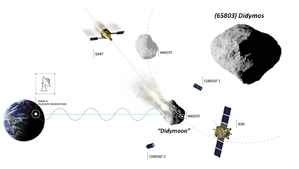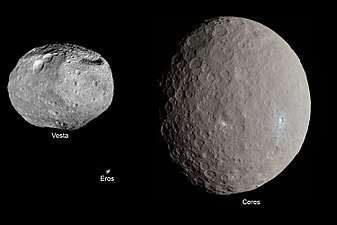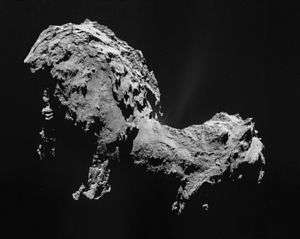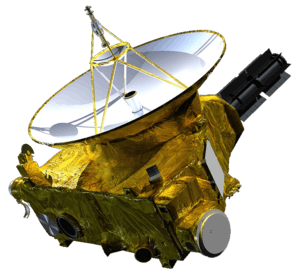AIDA (mission)
The Asteroid Impact and Deflection Assessment (AIDA) mission is a proposed pair of space probes which will study and demonstrate the kinetic effects of crashing an impactor spacecraft into an asteroid moon. The mission is intended to test and validate impact models of whether a spacecraft could successfully deflect an asteroid on a collision course with Earth.[5]
| Mission type | Dual asteroid probes |
|---|---|
| Operator | European Space Agency, NASA |
| Website | AIDA study |
| Start of mission | |
| Launch date | Hera: 2024 (planned) DART: 22 July 2021 (planned) |
| Rocket | |
| (65803) Didymos[2] orbiter | |
| Spacecraft component | Hera |
| Orbital insertion | January 2027[3] |
| (65803) Didymos[4] impactor | |
| Spacecraft component | DART |
| Impact date | October 2022 |
The original plan called for a European spacecraft, the Asteroid Impact Mission (AIM), to operate in synergy with a large NASA impactor called Double Asteroid Redirection Test (DART) and observe the immediate effects of the impact. AIM was cancelled in 2016 when Germany was unable to fund its portion, and after some backlash within ESA, AIM was replaced in 2018 with a smaller spacecraft called Hera that will launch five years after DART to orbit and study the crater on the asteroid.
DART is currently planned to impact in 2022 in the small moon of asteroid 65803 Didymos, while Hera will arrive at Didymos in 2027, five years after DART's impact.
History
Initially, Hera's role was to be realized by a much larger spacecraft called Asteroid Impact Mission (AIM),[6] that would have observed the plume, the crater, and the freshly exposed material to provide unique information for asteroid deflection, science and mining communities. In December 2016, the European Space Agency (ESA) cancelled the development of the AIM spacecraft after Germany decided to fund the ExoMars project only.[7] Germany offered to cover only 35 million of the 60 million needed for the AIM portion to continue,[7] and this was not enough to continue development.[8] Had AIM been developed, its notional requirements in 2012 were:[9][10]
- an asteroid lander (based on the German MASCOT heritage) for in-situ measurements
- a thermal infrared imager to discriminate different surface properties like rocks or granular surfaces
- a monostatic high frequency radar to obtain information on the structure of the asteroid's surface
- a bistatic low frequency radar (on the orbiter and on the lander) to allow a view inside the asteroid and obtain data on its inner structure
- two interplanetary CubeSats[11][12]
- deep-space optical communication.
Under the original proposal, AIM would have launched in October 2020, and DART in July 2021. AIM would have orbited the larger asteroid and studied the composition of it and its moon. DART would then impact the asteroid's moon in October 2022, during a close approach to Earth.[13] AIM would have studied the asteroid's strength, surface physical properties and internal structure, as well as measured the effect on the asteroid moon's orbit around the larger asteroid.
Nevertheless, NASA has continued development of the DART mission to 65803 Didymos, and plans to measure the effects of the impact from ground-based telescopes,[14][15] and from an Italian CubeSat DART will bring along. Following AIM's cancellation, ESA director Jan Wörner stated his intentions to revive the European mission in some form.[14] Etienne Schneider, Luxembourg's deputy prime minister, expressed regret at AIM's cancellation, and commented that his country would continue to advocate for the realization of the mission.[16]
Status
By March 2018, Hera proposal was in Phase B1, where the preliminary design was being drawn up. On 7 January 2019, the Hera team announced the selection of two CubeSats to piggyback on the mission: APEX and Juventas.[1] ESA officials approved Hera in November 2019 for a 2024 launch.[17]
The Italian Space Agency (ASI) decided in 2018 to contribute to NASA a secondary spacecraft called LICIA (Light Italian CubeSat for Imaging of Asteroids), a 6-unit CubeSat that will piggyback with DART and will separate shortly before impact to acquire images of the ejecta as it drifts past the asteroid.[18][19][20][21]
Collaboration
The AIDA mission is a joint international collaboration of the European Space Agency (ESA), the German Aerospace Center (DLR), Côte d'Azur Observatory (OCA), NASA, and Johns Hopkins University Applied Physics Laboratory (JHU/APL).[13]
The miniature lidar instrument on board Hera will be provided by a consortium of teams from Portugal, Poland, and Ireland.[2] Two CubeSats will be deployed by Hera while at Didymos:[22] The APEX (Asteroid Prospection Explorer) CubeSat is being developed by Sweden, Finland, Czech Republic and Germany.[23] The Juventas CubeSat is being developed by GomSpace and GMV's Romanian division.[23]
Along with surveying DART's impact crater, Hera may also carry a Japanese impactor that would be a replica of the Small Carry-on Impactor (SCI), on board the Hayabusa2 asteroid sample return mission.[6] NASA's DART will bring along a 6U CubeSat called LICIA which is being developed by the Italian Space Agency (ASI) to image the ejecta plume.[18][19][20]
Hera
| Mission type | Reconnaissance after the impact |
|---|---|
| Operator | ESA |
| Website | www |
| Spacecraft properties | |
| Launch mass | 870 kilograms (1,920 lb)[24] |
| Dry mass | 350 kilograms (770 lb)[24] |
| Start of mission | |
| Launch date | 2024[17] |
| Rocket | Ariane 6 |
| Launch site | Centre Spatial Guyanais, Kourou |
| Contractor | ArianeGroup |
| Dimorphos orbiter | |
Hera is the European component of the ESA–NASA AIDA mission. The Hera spacecraft, approved on 29 November 2019,[17] will focus on key measurements to validate impact and asteroid deflection models such as the detailed characterisation of the impact crater made by the DART impactor.[25] Hera will also measure the DART impact outcome, such as change in the binary system orbit,[25] and will enable detailed characterisation of the Dimorphos volume and surface properties, as well as measure the volume and morphology of the DART impact crater.[26]
The baseline payload of Hera is still in flux, and it includes a camera, a miniaturized lidar and two 6U CubeSats dedicated to asteroid characterisation. The spacecraft design allows for 40 kilograms (88 lb) of additional payload mass, including the Small Carry-on Impactor (SCI) proposed by Japan's space agency JAXA. Other options, such as a small lander, are being considered.[25] Hera will be launched on an Ariane 6[1] in 2024.[17]
Proposed payload
The notional payloads on Hera are:[10][6][2]
- Asteroid Framing Camera to obtain information on the dynamics of a binary asteroid and physical characteristics.[27]
- Lidar laser altimeter to measure the shapes of the two bodies and constrain the mass of the asteroid's moon.[27]
- Thermal imager[27]
- APEX (Asteroid Prospection Explorer) is a 6-unit CubeSat for spectral imaging and magnetic observations.[23] It will attempt to land on the asteroid surface for close-up data.[23]
- Juventas is a 6-unit CubeSat carrying a camera and a low-frequency radar for determining the internal structure of Dimorphos.[28] It will operate for 3–6 months near the asteroid.[3] At the end of its mission, it will attempt a landing on the surface of Dimorphos to obtain close-up data.[3]
- An optional impactor may also be carried by Hera.[2] It would be a replica of the Japan's Small Carry-on Impactor (SCI) on board the Hayabusa2 asteroid sample return mission.[6][2] By performing a secondary impact (the primary impact being DART's), a comparison of the effects posed by two collisions of different nature on the same asteroid can be realized, helping validate numerical impact algorithms and scaling laws.[2]
DART
DART or Double Asteroid Redirection Test is a 500 kilograms (1,100 lb) impactor that hosts a single camera, Didymos Reconnaissance and Asteroid Camera for OpNav (DRACO) to support autonomous guiding to impact the moon of (Didymos B) through its center.[29] It also carries an Italian-built cubesat called LICIACube that will be released pre-impact to image the event.[30] It is estimated that the impact of the 500 kilograms (1,100 lb)[31] DART at 6 kilometres per second (3.7 mi/s)[15] will produce a velocity change on the order of 0.4 mm/s, which leads to a small change in the orbit of the Didymos B, but over time, it leads to a large change in the orbital position (or orbital phase).[9][13][10]
Mission design
AIDA will target 65803 Didymos, a binary asteroid system in which one asteroid is orbited by a smaller one. The primary asteroid is about 800 metres (2,600 ft) in diameter; its small satellite is about 150 metres (490 ft) in diameter in an orbit about 1.1 km from the primary. Didymos is not an Earth-crossing asteroid, and there is no possibility that the deflection experiment could create an impact hazard to Earth.[10]
The impact of the 300 kilograms (660 lb) DART spacecraft at 6.25 km/s will produce a velocity change on the order of 0.4 mm/s, which leads to a significant change in the mutual orbit of these two objects, but only a minimal change in the heliocentric orbit of the system.[9][13][10] AIDA will provide a great benefit obtaining the size of the resulting impact crater in addition to the momentum transfer measurement, as the effects of porosity and strength of the target are needed to calculate the momentum transfer efficiency.[13][10]

DART is currently planned to impact in 2022 on the small moon of asteroid Didymos, while Hera will arrive at Didymos in 2027, five years after DART's impact, so in order to maximize scientific outcome, the AIDA team proposes to delay DART's launch so that Hera would arrive at the asteroid first, enabling it to study DART's impact, the plume, the crater, and the freshly exposed material.[6] While most of the initial objectives of AIDA would still be met if Hera arrives after DART, as a drawback data from direct observation of the impact and ejecta will not be obtained.[6]
| Host spacecraft | Secondary spacecraft | Remarks |
|---|---|---|
| DART | LICIA[18] |
|
| Hera | Juventas[28][3] | |
| APEX[23] | ||
| SCI |
See also
- Asteroid impact avoidance
- B612 Foundation
- Don Quijote, AIDA's predecessor proposal
- The Spaceguard Foundation
References
- Bergin, Chris (7 January 2019). "Hera adds objectives to planetary defense test mission". NASASpaceFlight.com. Retrieved 11 January 2019.
- Carnelli, Ian (11 October 2017). "The Hera Mission Study" (PDF). ESA. Retrieved 11 June 2018.
- The Juventas CubeSat in Support of ESA's Hera Mission to the Asteroid Didymos. Hannah R. Goldberg, Özgür Karatekin, Birgit Ritter, Alain Herique, Paolo Tortora, Claudiu Prioroc, Borja Garcia Gutierrez, Paolo Martino, Ian Carnelli. 33rd Annual AIAA/USU Conference on Small Satellites.
- "AIDA study". ESA. 19 December 2012. Archived from the original on 20 October 2014. Retrieved 19 September 2014.
- AIDA mission rationale Archived May 11, 2015, at the Wayback Machine. ESA, 25 May 2012.
- Michel, Patrick; Kueppers, Michael; Sierks, Holger; Carnelli, Ian (26 April 2017). "European component of the AIDA mission to a binary asteroid: Characterization and interpretation of the impact of the DART mission" (PDF). Advances in Space Research (Article) (published 18 December 2017). 62 (8): 2261–2272. doi:10.1016/j.asr.2017.12.020.
- ExoMars Rover Gets Funding Despite Schiaparelli Mars Lander Crash. Alixandra Caole Vila, Nature World News. 7 December 2016.
- NASA presses ahead with asteroid mission despite ESA funding decision. Jeff Foust, Space News. 13 December 2016
- Cheng, A.F.; Michel, P.; Reed, C.; Galvez, A.; Carnelli, I. (2012). DART: Double Asteroid Redirection Test (PDF). European Planetary Science Congress 2012. EPSC Abstracts.
- Michel, P.; Cheng, A.; Carnelli, I.; a. Rivkin, C.; Galvez, A.; Ulamec, S.; Reed, C. (February 2015). "AIDA: Asteroid Impact and Deflection Assessment Mission Under Study at ESA and NASA" (PDF). Observatoire de la Côte d'Azur. 1829: 6008. Bibcode:2015LPICo1829.6008M. Retrieved 29 March 2015.
- Cubesat Companions for ESA's Astroid [sic] Mission. Source: ESA. November 2, 2015.
- Lasagni Manghi, Riccardo; Modenini, Dario; Zannoni, Marco; Tortora, Paolo (2018). "Preliminary orbital analysis for a Cube Sat mission to the Didymos binary asteroid system". Advances in Space Research. 62 (8): 2290–2305. Bibcode:2018AdSpR..62.2290L. doi:10.1016/j.asr.2017.12.014.
- Asteroid Impact & Deflection Assessment (AIDA) study Archived 2015-06-07 at the Wayback Machine.
- Foust, Jeff (15 February 2017). "NASA presses ahead with asteroid mission despite ESA funding decision". SpaceNews. Retrieved 11 June 2018.
- Andone, Dakin (25 July 2017). "NASA unveils plan to test asteroid defence technique". CNN. Retrieved 25 July 2017.
- Henry, Caleb (15 February 2017). "Luxembourgian minister unwilling to let ESA asteroid mission die without a fight". SpaceNews. Retrieved 10 June 2018.
- Hera mission is approved as ESA receives biggest ever budget. Kerry Hebden, Room Space Journal. 29 November 2019.
- Asteroids have been hitting the Earth for billions of years. In 2022, we hit back. Archived 2018-10-31 at the Wayback Machine Andy Rivkin, The Johns Hopkins University Applied Physics Laboratory. September 27, 2018.
- Kretschmar, Peter; Küppers, Michael (20 December 2018). "The CubeSat Revolution" (PDF). ESA. Retrieved 24 January 2019.
- Double Asteroid Redirection Test: The Earth Strikes Back. Elena Adams; Daniel O'Shaughnessy; Matthew Reinhart, etal. 2019 IEEE Aerospace Conference; 2-9 March 2019. doi:10.1109/AERO.2019.8742007 Quote: "In addition, DART is carrying a 6U CubeSat provided by Agenzia Spaziale Italiana (ASI). The CubeSat will provide imagery documentation of the impact, as well as in situ observation of the impact site and resultant ejecta plume".
- DART Impact Ejecta Simulation and Visualization for Fly-Along CubeSat Operational Planning. Fahnestock, E.; Yu, Y.; Cheng, A. F. Astronomy Abstract Service; December 2018.
- Carnelli, Ian (31 January 2018). "Status of AIM/Hera" (PDF). ESA. Retrieved 11 June 2018.
- "CubeSats joining Hera mission to asteroid system". Space Daily. 8 January 2019. Retrieved 11 January 2019.
- Hera. European Space Agency. Accessed on 1 December 2019.
- The Hera mission: European component of the ESA-NASA AIDA mission to a binary asteroid. Michel, Patrick; Küppers, Michael; Carnelli, Ian. 42nd COSPAR Scientific Assembly. Held 14-22 July 2018, in Pasadena, California, USA, Abstract id. B1.1-42-18
- Numerical modelling of the DART impact and the importance of the Hera mission. Sabina D. Raducan, Thomas M. Davison, Gareth S. Collins. PDC 2019. Washington, D.C., USA.
- Exploration of the binary asteroid 65803 Didymos by the Hera mission. EPSC Abstracts. Vol. 13, EPSC-DPS2019-583-1, 2019. EPSC-DPS Joint Meeting 2019. 15-20 September 2019.
- A Low Frequency Radar to Fathom Asteroids from Juventas Cubesat on HERA. Alain Herique, Dirk Plettemeier, Wlodek Kofman, Yves Rogez, Christopher Buck, and Hannah Goldberg. EPSC Abstracts. Vol. 13, EPSC-DPS2019-807-2, 2019. EPSC-DPS Joint Meeting 2019.
- https://www.nasa.gov/sites/default/files/atoms/files/fy2021_congressional_justification.pdf - 10 February 2020

- "LICIACUBE: NASA CHOOSES AN ARGOTEC'S SMALLSAT!". Argotec.
- DART: Home page at APL Archived 2018-05-10 at the Wayback Machine. DART Spacecraft. APL, 2017.
External links
- ESA Hera page
- Sciency Words: Didymoon
- Video: 5 min presentation of AIDA, at YouTube.





